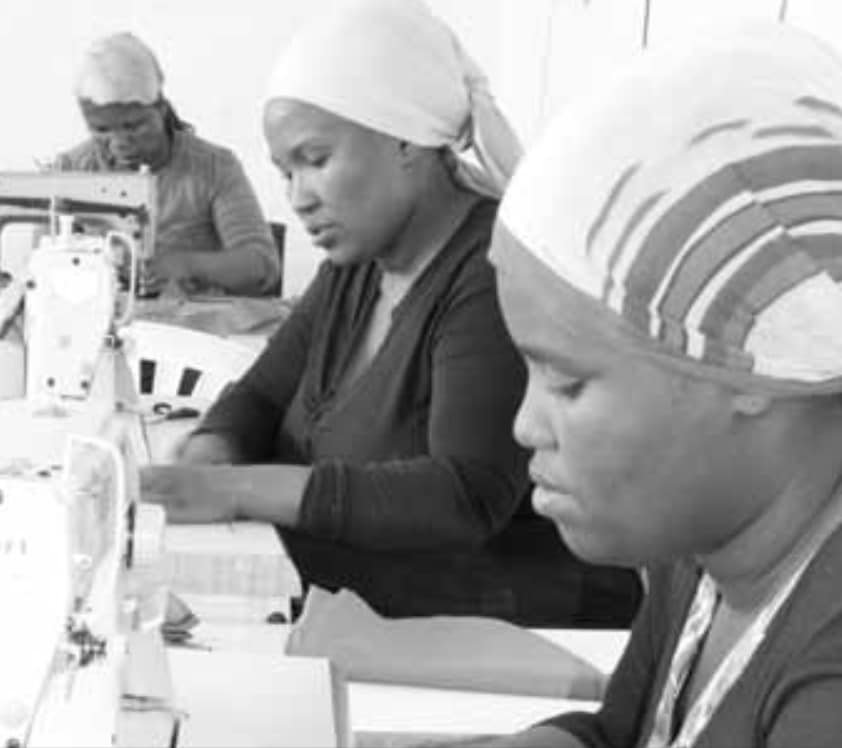SALDANHA, South Africa – The sound of sewing machines fills the room with a low, continuous hum. A handful of women sit behind the machines, their heads bent in concentration on their work.
The seamstresses belong to a business development project run by the West Coast Business Development Centre (WCBDC) in Saldanha, which aims to provide previously unemployed people with stable incomes and business support.
“I am working with the sewing project for three years now. I feel lucky because lots of people don’t have jobs in this area,” says Antonia Kuzani, one of the seamstresses.
The shy and soft-spoken 25-yearold used to work as a cleaner, but was unemployed for three years after being retrenched.
“For a long time, I was looking for a job, but I couldn’t find one because there is lots of unemployment. For a while, I tried to make money from selling sweets on the street, but I didn’t make enough to survive,” she says.
She earns $215 a month working for the sewing project, which she says is just enough to make ends meet and send her nine-year-old son to school: “My salary is gone after I pay for rent, water, electricity, food, clothing and school fees. My transport to work alone is R280 ($38) a month. All of the money is gone for those basics.”
Kuzani and her colleagues are on contract to manufacture more than 1,000 work shirts per year for South African mining group Exxaro Sands. They also produce a few hundred laundry bags for Duferco Steel Processing.
Their business is founded on the concept that large manufacturers who own factories in the Saldanha Bay area may outsource some of their supply chain through the WCBDC to small businesses like the sewing project, and thereby help to grow them.
“The business development centre was brought about when big corporates (who moved their operations into the Saldanha Bay area) saw a gap in the market of small, local suppliers they can draw resources from. They needed to outsource smaller production jobs and wanted to invest in communities at the same time,” explains WCBDC chief executive officer Abigail Murray.
A number of major companies, including Exxaro, Duferco Steel, Transnet National Ports Authority and ArcelorMittal, teamed up in 1998 to set up a corporate social responsibility initiative intended to reduce high unemployment in the Saldanha Bay region. The outcome was WCBDC and a database of small-scale suppliers.
The sewing project was one of the first small business development initiatives started by WCBDC in June 2001. That year’s census captured unemployment figures in the municipality’s two main towns, Saldanha and Vredenburg, of 27 and 28 percent respectively.
The sewing project has yet to become a sustainable business and provides employment to only four people. “We need more orders and more clients if we want to grow the business and make more money,” says Kuzani.
Her colleague, Nondumiso Ntoyakhe, a sturdy 29-year-old who used to be a seasonal farm worker-unemployed for most months of the year agrees, “The sewing project is a big improvement to our lives, but the income is still not enough.”
The project was started with a financial injection of $7,600 from the Anglo American Group, to which Exxaro Sands belong, Shell and the South African Department of Labour. Twenty-four local unemployed women were trained in technical sewing and business management.
“Most of them have moved on and are either employed elsewhere or have their own little business. Only a few women are still working with the project,” says Murray.
Despite the centre’s efforts to boost small business development, most start-ups struggle to build sustainable operations. “The sewing project, for example, is running at a loss at the moment. It’s subsidized by WCBDC. Unfortunately, that’s everyone’s story. It’s never enough, and unemployment is a big problem throughout the region,” she says.
The idea behind the WCBDC initiative is to set up small businesses and support them with mentoring and training, but ultimately they are expected to operate and be profitable on their own. When this becomes too difficult, people either try to keep up one-person operations from home or find employment with larger companies throughout the province.
Ntoyakhe believes it’s not enough for big businesses to create jobs-government also needs to show greater commitment to reducing unemployment in the region. “Government needs to invest more money into businesses here. Lots of people are not working. Lots of companies have closed down. If there were jobs, everything would be better,” she says. “People are forced into crime because there is no money.”
In the first few years of its existence, the business development centre received financial support from the South African Department of Labour, but the funding ceased about five years ago. Murray believes the funding period was too short to create long-term sustainability.
“There used to be a big drive from government to support small business development, but we were told to move away from the dependency and start projects that generate income and real jobs,” says Murray.
Courtesy of Inter Press Service




